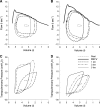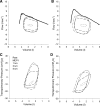Heliox breathing equally influences respiratory mechanics and cycling performance in trained males and females
- PMID: 25429095
- PMCID: PMC4312847
- DOI: 10.1152/japplphysiol.00400.2014
Heliox breathing equally influences respiratory mechanics and cycling performance in trained males and females
Abstract
In this study we tested the hypothesis that inspiring a low-density gas mixture (helium-oxygen; HeO2) would minimize mechanical ventilatory constraints and preferentially increase exercise performance in females relative to males. Trained male (n = 11, 31 yr) and female (n = 10, 26 yr) cyclists performed an incremental cycle test to exhaustion to determine maximal aerobic capacity (V̇o2max; male = 61, female = 56 ml·kg(-1)·min(-1)). A randomized, single-blinded crossover design was used for two experimental days where subjects completed a 5-km cycling time trial breathing humidified compressed room air or HeO2 (21% O2:balance He). Subjects were instrumented with an esophageal balloon for the assessment of respiratory mechanics. During the time trial, we assessed the ability of HeO2 to alleviate mechanical ventilatory constraints in three ways: 1) expiratory flow limitation, 2) utilization of ventilatory capacity, and 3) the work of breathing. We found that HeO2 significantly reduced the work of breathing, increased the size of the maximal flow-volume envelope, and reduced the fractional utilization of the maximal ventilatory capacity equally between men and women. The primary finding of this study was that inspiring HeO2 was associated with a statistically significant performance improvement of 0.7% (3.2 s) for males and 1.5% (8.1 s) for females (P < 0.05); however, there were no sex differences with respect to improvement in time trial performance (P > 0.05). Our results suggest that the extent of sex-based differences in airway anatomy, work of breathing, and expiratory flow limitation is not great enough to differentially affect whole body exercise performance.
Keywords: exercise; expiratory flow limitation; sex differences; ventilatory limitations to exercise.
Copyright © 2015 the American Physiological Society.
Figures




Similar articles
-
Role of expiratory flow limitation in determining lung volumes and ventilation during exercise.J Appl Physiol (1985). 1999 Apr;86(4):1357-66. doi: 10.1152/jappl.1999.86.4.1357. J Appl Physiol (1985). 1999. PMID: 10194223 Clinical Trial.
-
Ventilatory response to exercise in subjects breathing CO2 or HeO2.J Appl Physiol (1985). 1997 Mar;82(3):746-54. doi: 10.1152/jappl.1997.82.3.746. J Appl Physiol (1985). 1997. PMID: 9074958
-
Ventilation and respiratory mechanics during exercise in younger subjects breathing CO2 or HeO2.Respir Physiol. 1997 Jul;109(1):15-28. doi: 10.1016/s0034-5687(97)84026-1. Respir Physiol. 1997. PMID: 9271804
-
Revisiting dysanapsis: sex-based differences in airways and the mechanics of breathing during exercise.Exp Physiol. 2016 Feb;101(2):213-8. doi: 10.1113/EP085366. Epub 2015 Nov 17. Exp Physiol. 2016. PMID: 26440369 Review.
-
Does gender affect pulmonary function and exercise capacity?Respir Physiol Neurobiol. 2006 Apr 28;151(2-3):124-31. doi: 10.1016/j.resp.2005.10.010. Epub 2006 Jan 10. Respir Physiol Neurobiol. 2006. PMID: 16406740 Review.
Cited by
-
Effect of Regular Yoga Practice on Respiratory Regulation and Exercise Performance.PLoS One. 2016 Apr 7;11(4):e0153159. doi: 10.1371/journal.pone.0153159. eCollection 2016. PLoS One. 2016. PMID: 27055287 Free PMC article.
-
Sex, gender and the pulmonary physiology of exercise.Eur Respir Rev. 2022 Jan 12;31(163):210074. doi: 10.1183/16000617.0074-2021. Print 2022 Mar 31. Eur Respir Rev. 2022. PMID: 35022254 Free PMC article. Review.
-
Cardiorespiratory Fitness and Performance Adaptations to High-Intensity Interval Training: Are There Differences Between Men and Women? A Systematic Review with Meta-Analyses.Sports Med. 2024 Jan;54(1):127-167. doi: 10.1007/s40279-023-01914-0. Epub 2023 Sep 7. Sports Med. 2024. PMID: 37676620 Free PMC article.
-
Ventilatory Limitation of Exercise in Pediatric Subjects Evaluated for Exertional Dyspnea.Front Physiol. 2019 Jan 29;10:20. doi: 10.3389/fphys.2019.00020. eCollection 2019. Front Physiol. 2019. PMID: 30761012 Free PMC article.
-
The effects of antioxidant vitamin supplementation on expiratory flow rates at rest and during exercise.Eur J Appl Physiol. 2015 Oct;115(10):2049-58. doi: 10.1007/s00421-015-3183-z. Epub 2015 May 19. Eur J Appl Physiol. 2015. PMID: 25987441 Clinical Trial.
References
-
- American Thoracic Society. Standardization of Spirometry, 1994 Update American Thoracic Society. Am J Respir Crit Care Med 152: 1107–1136, 1995. - PubMed
-
- Amann M, Hopkins WG, Marcora SM. Similar sensitivity of time to exhaustion and time-trial time to changes in endurance. Med Sci Sports Exerc 40: 574–578, 2008. - PubMed
-
- ATS. ATS/ERS Statement on respiratory muscle testing. Am J Respir Crit Care Med 166: 518–624, 2002. - PubMed
-
- Babb TG. Breathing He-O2 increases ventilation but does not decrease the work of breathing during exercise. Am J Respir Crit Care Med 163: 1128–1134, 2001. - PubMed
-
- Babb TG. Ventilation and respiratory mechanics during exercise in younger subjects breathing CO2 or HeO2. Respir Physiol 109: 15–28, 1997. - PubMed
Publication types
MeSH terms
Substances
LinkOut - more resources
Full Text Sources
Other Literature Sources
Medical
Miscellaneous

